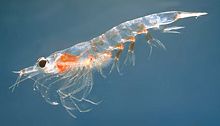| Krill | |
|---|---|

| |
| Northern krill (Meganyctiphanes norvegica) | |
| Scientific classification | |
| Domain: | Eukaryota |
| Kingdom: | Animalia |
| Phylum: | Arthropoda |
| Class: | Malacostraca |
| Superorder: | Eucarida |
| Order: | Euphausiacea Dana, 1852 |
| Families and genera | |
| |
Krill (Euphausiids)[1] (sg.: krill) are small and exclusively marine crustaceans of the order Euphausiacea, found in all the world's oceans.[2] The name "krill" comes from the Norwegian word krill, meaning "small fry of fish",[3] which is also often attributed to species of fish.
Krill are considered an important trophic level connection near the bottom of the food chain. They feed on phytoplankton and, to a lesser extent, zooplankton, and are also the main source of food for many larger animals. In the Southern Ocean, one species, the Antarctic krill, makes up an estimated biomass of around 379 million tonnes,[4] making it among the species with the largest total biomass. Over half of this biomass is eaten by whales, seals, penguins, seabirds, squid, and fish each year. Most krill species display large daily vertical migrations, providing food for predators near the surface at night and in deeper waters during the day.
Krill are fished commercially in the Southern Ocean and in the waters around Japan. The total global harvest amounts to 150,000–200,000 tonnes annually, mostly from the Scotia Sea. Most krill catch is used for aquaculture and aquarium feeds, as bait in sport fishing, or in the pharmaceutical industry. Krill are also used for human consumption in several countries. They are known as okiami (オキアミ) in Japan and as camarones in Spain and the Philippines. In the Philippines, they are also called alamang and are used to make a salty paste called bagoong.
Krill are also the main prey of baleen whales, including the blue whale.
- ^ "Euphausiids (Krill)". Government of Canada. Fisheries and Oceans Canada. 6 April 2022. Retrieved 18 April 2024.
Many different species of euphausiids are found on Canada's east and west coasts.
- ^ Crustacea: Euphausiacea - Oxford Academic
- ^ "Krill". Online Etymology Dictionary. Retrieved 22 June 2010.
- ^ A. Atkinson; V. Siegel; E.A. Pakhomov; M.J. Jessopp; V. Loeb (2009). "A re-appraisal of the total biomass and annual production of Antarctic krill" (PDF). Deep-Sea Research Part I. 56 (5): 727–740. Bibcode:2009DSRI...56..727A. doi:10.1016/j.dsr.2008.12.007.